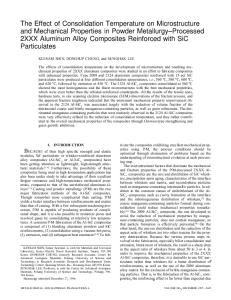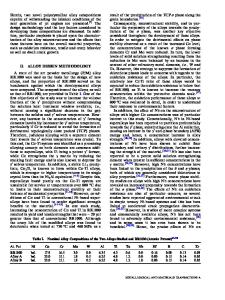Effect of porosity on the electrical properties of Fe-based specimens fabricated by powder metallurgy
- PDF / 863,115 Bytes
- 4 Pages / 612 x 792 pts (letter) Page_size
- 4 Downloads / 266 Views
-RAMOS, Doctoral Student, and A. MANZANO´ NDEZ, Research RAMI´REZ, Y. VOROBIEV, and J. GONZALEZ-HERNA Fellows, are with CINVESTAV-IPN, Unidad Quere´taro, Real de Juriquilla 76230, Quere´taro, Qro., Mexico. Contact e-mail: manzano@sunserver. uaq.mx Manuscript submitted February 27, 2002. 126—VOLUME 34B, FEBRUARY 2003
⫽ 2s(V /I ) F
[1]
where F is the correction factor, which depends on the ratio t/s; in our experiments, t/s ⫽ 1.33, and the F factor is equal to 0.8. These measurements were taken at several points on the gear with the probe oriented at different directions. This procedure prevents the measurements from being influenced by possible anisotropies in the material. The four-probe method gives the resistivity average over the nearby volume with the thickness of the order of the interprobe spacing.[9,10] Because the spacing is large compared to the size of the initial powder grain and to the pore’s size, it is considered that the measured resistivity represents the bulk resistivity. The porosity and resistivity were measured at the same points and a direct relationship was found between both values. For the resistivity measurements, five pieces of the sample were cut and ground using emery paper, 100, 240, 320, 400, and 500 grit. Afterward, the piece was polished with 3-m diamond paste. Finally, the samples were etched with 2 pct nital. After the mechanical treatment, the surface morphology and the surface chemical analysis were obtained using scanning electron microscopy (SEM). The percentage of porosity was determined from the observation of the surface of each sample using a computer-based image analyzer. In addition to the resistivity measurements, the distribution of the electric field created in a sample (due to the voltage applied to the gear material between two parallel electrodes) was also studied. This analysis was done in each one of the regions encircled in Figure 2. In one of these circles, the position of the electrodes (e) through which a constant current (1 A) was applied is shown. These coplanar, 22-mm-long electrodes are offset ⫾4 mm from the radius of the gear, giving an interelectrode spacing of 8 mm. The interelectrode resistance estimated from the voltage applied to them is of the same order of magnitude as that measured using the fourprobe method. To investigate the electric field pattern, the voltage was measured using another set of two small point electrodes with a fixed distance of 3 mm between them. The voltage was measured along different orientations in the sample with respect to the perpendicular direction to the two large electrodes (e), at 0 deg, ⫾45 deg and 90 deg (i.e four measurements). It is clear that the interelectrode voltage difference will be the largest when the projection of the interelectrode spacing on the field direction is the maximum. The measurements described previously were repeated at different parts of each gear. It is easy to show that, for a uniform field distribution, the dependence of the voltage measured in this way on the angle between the fi
Data Loading...











